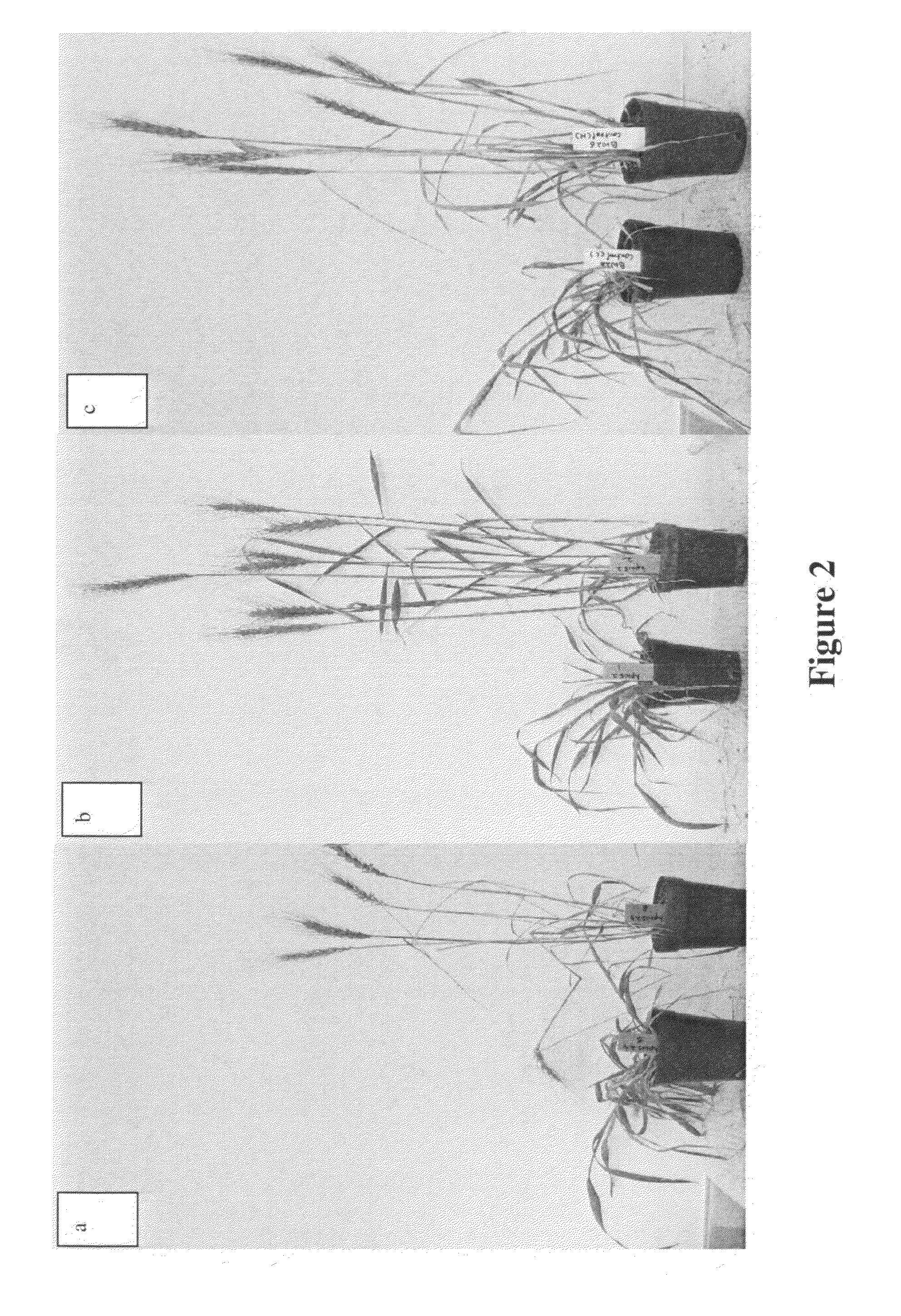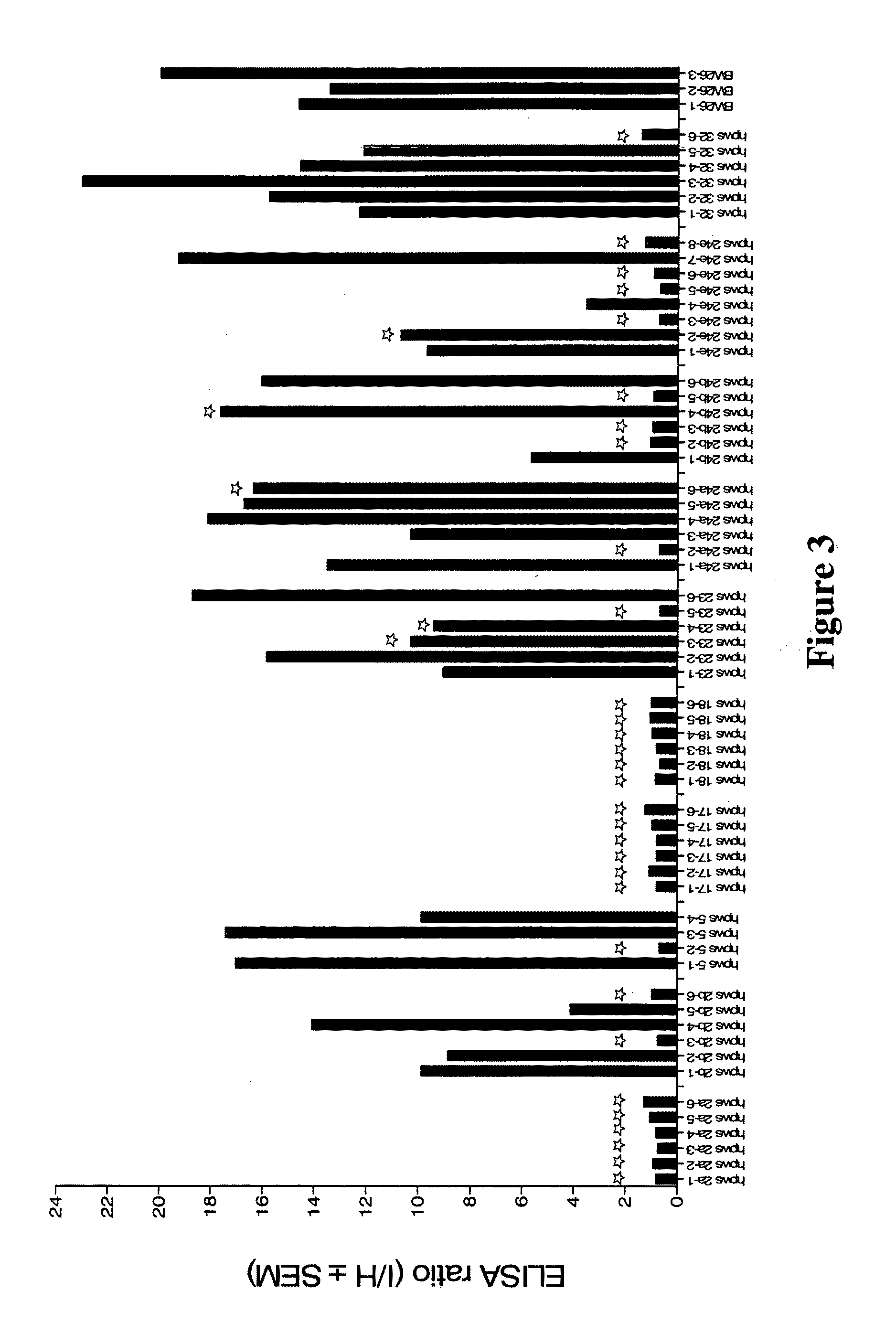Wheat plants with immunity to wheat streak mosaic virus (WSMV)
a technology of mosaic virus and wheat, applied in the field of transgenic wheat plants, can solve the problems of high temperature, large yield penalty, limited usefulness,
- Summary
- Abstract
- Description
- Claims
- Application Information
AI Technical Summary
Benefits of technology
Problems solved by technology
Method used
Image
Examples
example 1
Generation of Hairpin RNAi Construct Targeting WSMV
[0134]Wheat streak mosaic virus sequences were retrieved using VirusFASTAs® Rothamsted Research Institution Version 2005.05.20. Sequences of NIa region from five full genome sequences (Type strain with Genbank Accession No. AF285169, Turkey Isolate Accession No. AF454455, Czech Isolate Accession No. AF454454, El Batan strain Accession No. AF285170 and Sydney Isolate Accession No. AF057533) were retrieved and aligned using AlignX (Vector NTI Advance® 10.3.0). This identified a highly conserved portion of the NIa gene of WSMV (FIG. 1a) which was amplified by PCR and cloned into the vector pStargate, to generate the pStargate-NIa (FIG. 1b) that would transcribe into a hairpin RNA. Primers were designed against the NIa gene (FIG. 1a) based on the most conserved regions identified from the alignment. Leaf samples were collected from WSMV-infected wheat plants and preserved at −80° C. until RNA was extracted from them. RNA was extracted f...
example 2
Transformation of Wheat Embryos and Regeneration of Transgenic Plants
[0139]Despite the fact that the transformation vector was a binary plasmid, biolistics rather than Agrobacterium-mediated transformation was employed to generate transgenic wheat plants containing the RNAi construct. Although a hygromycin selectable marker was present on pStargate-NIa, transformation selection was based on co-bombardment with pNeo (Pharmacia) containing a nptII marker and transformants were selected with 50 mg.l-1 geneticin.
[0140]The scutella of 450 freshly isolated embryos from BobWhite 26 spring wheat, at about 14 days post-anthesis were co-transformed by biolistics bombardment with DNA of pStargate-NIa and pNeo (Pharmacia) carrying nptII as plant selectable marker. Three fold greater weight of pNeo was used to give approximately equal moles of the two plasmids. The biolistics and tissue culture protocols were largely as described by Pellegrineschi et al., 2002. The only modification was the use ...
example 3
Methods for Analysis of Transgenic Plants
[0142]DNA extraction was carried out from leaf samples using “DNAeasy Plant Mini Kit” following manufacturer's instructions (Qiagen Inc., Valencia, Calif. USA) and PCR was carried out for selectable marker nptII using PCR. A 700-bp nptII fragment was amplified using the forward primer Neo3 5′-tacggtatcgccgctcccgat-3′ and reverse primer Neo5 5′-ggctattcggctatgactg-3′, both sequences being in the nptII coding region using the following thermal cycle conditions: 94° C. for 30 s, 55° C. for 30 s, 72° C. for 60 s for 40 cycles with a final extension at 72° C. for 10 min.
Analysis of T0 Transgenic Plants—Southern Hybridization Method
[0143]Wheat genomic DNA was extracted from transgenic wheat by standard methods. Approximately 15 μg of DNA was digested overnight with BamHI and separated by 0.8% agarose gel electrophoresis (Sambrook, 2001) and the DNA transferred onto a nylon membrane (Pall Biodyne® B), followed by standard hybridization procedures (S...
PUM
| Property | Measurement | Unit |
|---|---|---|
| temperature | aaaaa | aaaaa |
| ionic strength | aaaaa | aaaaa |
| pH | aaaaa | aaaaa |
Abstract
Description
Claims
Application Information
 Login to View More
Login to View More - R&D
- Intellectual Property
- Life Sciences
- Materials
- Tech Scout
- Unparalleled Data Quality
- Higher Quality Content
- 60% Fewer Hallucinations
Browse by: Latest US Patents, China's latest patents, Technical Efficacy Thesaurus, Application Domain, Technology Topic, Popular Technical Reports.
© 2025 PatSnap. All rights reserved.Legal|Privacy policy|Modern Slavery Act Transparency Statement|Sitemap|About US| Contact US: help@patsnap.com



